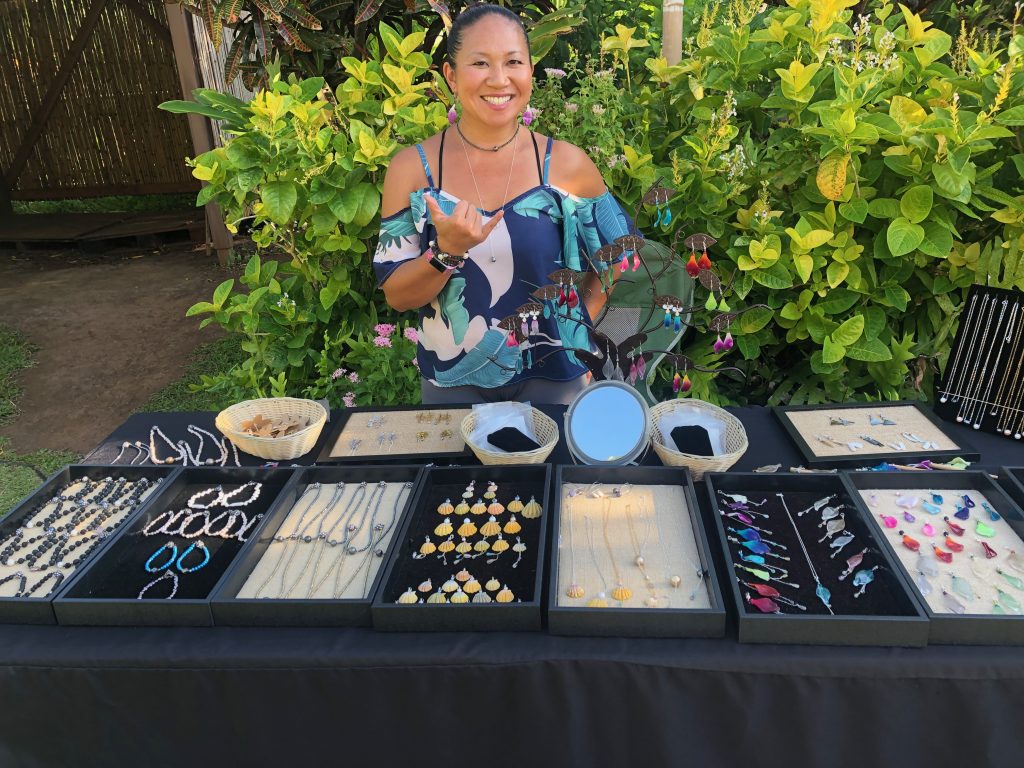Mele Luau Honolulu | How To Make A Tropical Themed Arts and Crafts In Kapolei
Show up early for Hawaiian Cultural Experiences, craft fair, and outdoor adventures
- Poi Ball Lessons
- Hula Lessons
- Pareo Tying Demonstration
- Small Hawaiian Tattoos
Read Post
Hawaiian Cultural Activities
Poi Spinning Classes
Looking for Poi Spinning classes near me? Staying in Hawaii and want to learn about Poi Spinning Balls? We do it Mele Luau!
Poi was created in New Zealand by a dancer and spinner of spinning balls, which are attached to nylon tethers. The ancient Maoris used to wave weights in air, creating hypnotic patters. They were also preparing to battle, but that’s another story. Children and adults all over the globe love to create amazing visual effects with Poi moves.
This is a brief introduction to poi ball spinning. Poi is an innovative and beautiful art form. Movement art that is rooted in tribal traditions of Maori peoples. New Zealand over the years has assimilated parts of everything.
Club swinging, juggling and glow stringing are just a few of the many activities that can be done to make your club a great place to hang out.
modern in diverse movement art. You can practice it as an individual, in groups, on a stage or as a private meditation. We will teach you how to move with poi and the parts.
Let’s start by discussing the components of poi.
There are many types of poi. No matter which set of poi you choose, they are all great!
Regardless of which model you are using, the basic components will be the same. These are the components.
The components include the head, which is typically the farthest component. The body is kept away from the ground and it swings in the geometric patterns.
We associate with poi.

The tether is a flexible material that joins the head.
The handle is what holds the poi in place.
Your hand will move with the handle. Handles come in three different styles.
The first style is a single-loop handle, which consists of one strip of fabric.
It is wrapped around the hand and tied in a slipknot. How to do
This is how it works: pinch the handle between your fingers and then turn the loop inside-out and reach the end of it around your fingers. If you pull it tight, it will create a slip knot.
This is the best option for security.
One that is less likely to cause you losing control of the poi, or letting it go.
A double loop handle is another option. Double loop handles look very similar to single loop.
It is made up of two strips of fabric, rather than one.
The last option is what’s known as a ball handle.
A ball handle is a solid object that is roughly spherical.
It’s designed to stop the poi from moving and is shaped in a certain way. If you need to release the poi intentionally, such as if you are going to perform contact rolls or other activities, you can use ball handles.
Throws are the most secure choice in terms of how you can use them.
The most popular option for practicing poi is sock, or sometimes fabric poi. This is a combination of some type of weight that has been dropped into either a fabric sleeve, or a sock.
These are the most popular option and are often a person’s first choice.
Set of poi. Next, we have the flag or Zuni poi which have a stripe of fabric attached to their heads.
These enable you to see in certain ways the trail of the poi while it spins
around. If you’re just starting out and your planes don’t look as clean, they can also get in the way of each other.
Contact poi are a form of contact juggling balls that have been connected by a chain or rope to what is usually a handle. They can be used to create tricks in which the ball moves around on different parts.
Glow poi can also be used in dark environments like the outdoors.
Late at night or in clubs The inside of the lamp will have an LED and a battery.
Make sure your head is up so it can be seen in the dark.
Fire poi are a third option. They consist of a fire poi head, which is a Kevlar rope connected via technora rope or chain to a handle of various types.
The obvious question now is how do you hold the poi correctly?
The truth is that there is no right or wrong way.
Poi practice is the most important thing.
Find a grip that is comfortable and makes you want the poi to be picked up and used.
These are some suggestions that I have based on grips that other poi spinners have used.
Your grip will come regardless of what poi you use.
It all comes down to the two fingers that you will use to attach the poi to each finger.
This ball handle is best used to grip the handles.
Ball between your index finger and your thumb. The tether should be pressed in between the thumb and index finger.
The thumb is located between your thumb and index finger’s second joint.
As though you are pressing a button on your remote control.
Another option is to place the ball near the edge of your hand.
Where the pinky meets flesh Then, you hold onto the tether and pinch.
The end using the same method.
Some poi tricks are easier when you have shorter tethers. You don’t have to cut down your tethers, and you can still use the same poi tricks. There is an alternative: temporarily making them shorter so that you can extend them again if necessary.
Wrap the tether around the back of your hand (the one with the knuckles) and wrap it under your palm like you are going to tie it around.
Then, you’ll need to pinch the tether between index and thumb.
Complete the ball grip that we discussed in the previous section.
This will allow your tether to be as short or long as you like.
If you prefer, you can always do them later.
This is very handy for tricks such as the buzzsaw. Here you keep the poi.
You want to be as close to your body as possible, but you also want to ensure that you aren’t
You can actually hit yourself.
Wrap the poi around your fingers and ensure that the ends are the same length.
Now you are familiar with the basic principles of poi construction and how they can be held.
It’s time for you to learn how to move with them, and different poi tricks.
Learn about poi spinning balls by visiting Mele Luau Oahu!

How To Tie A Pareo
Pareos, or Tahitian or Cook Island fabric wraps, are stunning. Pareos are similar to sarongs and can be used in many different ways. A pareo can be tied in many different ways. You can tie it like a sarong or tie it into an outfit such as a jacket or dress. Or you can use a buckle to attach it to a skirt. These options are quick and easy and will create a stunning beach look. Below are some examples of how you can style and wear your pareo.
How To Tie A Hawaiian Sarong
Pareos or sarongs make great beach covers. The pareo is a part of many women’s everyday wardrobe in many cultures. Let me show you how to style a pareo and what to do with it when you’re not at the beach.
They can be used as a quick covering, a towel, a picnic blanket, or as a hair scarf. You can use the sarong for so many purposes. Ask the women in India, Southeast Asia, and Africa who have worn them for centuries. While the western version may not be as comfortable, a Sarong is simply a wide swathe of fabric that’s wrapped around the body and tied.
A sarong, when it comes to beachwear, is far easier than a tunic that you have to pull over your head. It’s also far more comfortable than denim cutoffs. You could tie the sarong at your hip by simply knotting two corners. But, for those who want to experiment with new styles, this is how you tie a Sarong in nine different ways.
(Pro tip: If you don’t have enough fabric for a proper knot, you can use a hair tie or a butterfly clip to keep your sarong in its place.
Visit Us
Pareo Tying
Pareos have a simple design. Many summer outfits can be created from this simple design. How you wrap it will determine how creative. To create a flowing, light and fluid skirt, a long pareo can be tied at your hips. The versatility of a short pashmina-type scarf is its ability to be worn in multiple ways. You can wear it as a scarf around your neck or as a dress. Simply wrap the pareo around your hips until it covers your buttocks. Then tie the ends. You can fold the square style in half and tie it at the sides.
Pareos are versatile pieces of clothing that can be worn as tops for any occasion. This bustier cut is ideal for sunbathing at the beach. This outfit can be worn over a bandeau swimsuit to show off your shoulders. Wrap the pareo around your upper body, and tie a knot between the breasts or on the side. A Tahitian pareo is another option, which has a knot at the shoulder.
This top is sophisticated and sensual, with a front opening that allows for glimpses of your stomach. For a choker effect, fold the sarong in half lengthwise. Wrap it around your neck and wear it as a scarf. The two pieces at the back should be crossed at the shoulder blades. Next, bring the pieces to the front under your arms. The top corners should be tied at the hollow of your chest. Let the remaining two pieces fall to your hips. This will reveal a portion of your belly.
A beach dress is one of many outfits that every woman should have, but the pareo has the advantage that you can wear it in so many different ways. It can be worn at the beach, in town or in the summer as a long elegant dress.
A popular style is a dress wrapped over your neck. It looks fantastic with a neckline or halter-top swimwear. Starting from the rear of the pareo, move the ends to the front to produce this effect. They should be crossed and tied around your collar. The uneven variant of a shoulder knot is beautiful. To make this outfit a personalized evening dress, mix it with stylish strappy sandals or a shawl.
Ways To Tie a Pareo
A ring or a buckle can be used as a fashion embellishment to finish off a pareo. This exotic decorative element, usually made from wood, is used as a fastener. For a fitted gown, place the pareo behind you. If you are making a skirt, place it below your waist. Pass the ends of the pareo to the front by pulling them towards the center. To ensure that you are comfortable, bring the ring as close to your body as possible. Next, wrap each piece around the sides and tie them behind your back at the level of your kidneys or shoulder blades. For a draped effect, leave the fabric a little loose.
Find Us Here!
